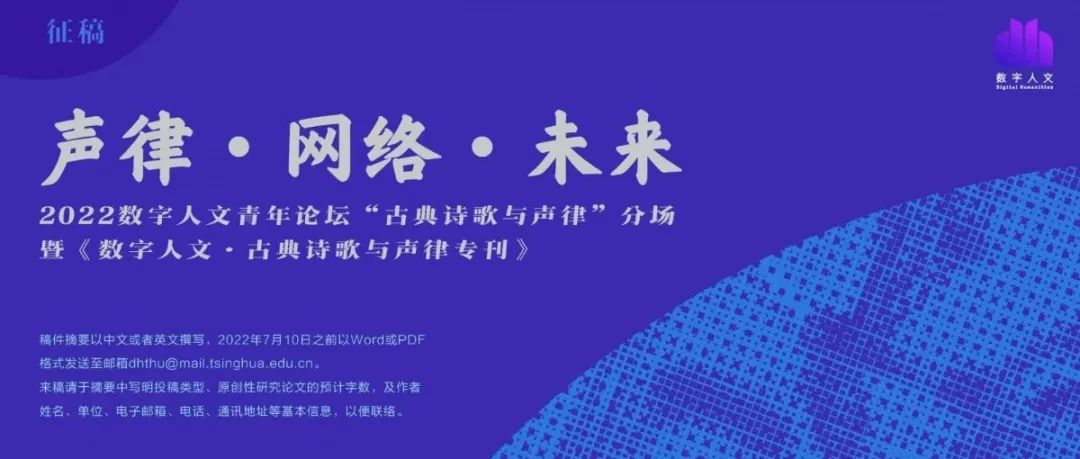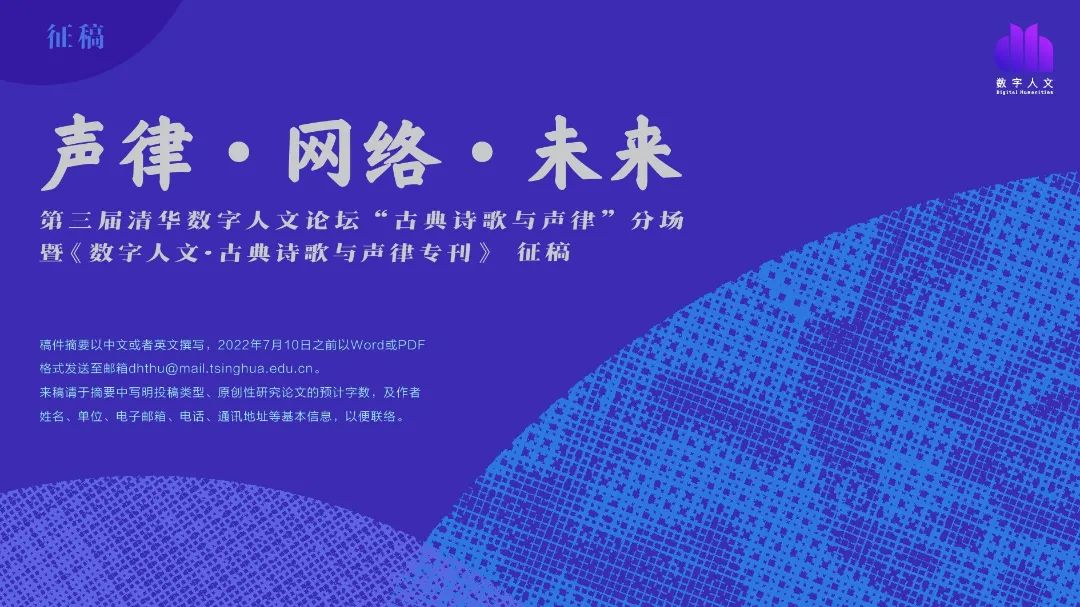


《数字人文》编辑部拟于清华大学人文学院成立十周年之际(2022年10月29-30日),举办“声律·网络·未来——第三届清华数字人文论坛”,论坛分设古典诗歌与声律、网络分析及未来学者三个专题。古典诗歌与声律专场现面向海内外学者、团队诚征稿件摘要,入选者将受邀在论坛宣讲,我们也将择优稿刊发在《数字人文》“古典诗歌与声律专刊”(Special Issue on Classic Poetry and Prosody Study )。
近年来大数据与人工智能手段逐步应用于古代文学研究,计量诗律学(Analysis Meter)悄然兴起,全样本和自动标注算法为以事实数据验证前人声律学说提供了可能,古典诗歌声律的量化研究也成为数字人文方法的重要放矢之的,与网络分析、GIS及基于语义技术的文本挖掘等方法的诗歌研究一道,共同构成古典诗学学术的未来亮点。
《数字人文》(Journal of Digital Humanities)是清华大学、中华书局联合主办的学术季刊,秉持以学科交叉促学术创新的理念,旨在为数字人文领域的探索研究提供理论探讨和专题研究的平台。
会议和专刊均接受中文及英文稿件,欢迎数字人文与诗律学交叉领域的最新学术成果,包含但不限于古典诗律研究,相关数据库与分析工具建设,国内外优秀研究案例评介,以及其他运用数字人文方法的古典诗歌研究。
来稿人须于2022年7月10日前提交稿件摘要。原创性研究论文的摘要字数800-1500字,其他类型的稿件摘要不多于800字。原创性研究论文的摘要建议包括以下三方面:
研究背景——概括性介绍论文中将要解决的研究课题和具体问题;
研究方法和数据——简要介绍研究中使用的数据和分析方法;
研究结论——总结研究成果。
稿件摘要以中文或者英文撰写,2022年7月10日之前以Word或PDF格式发送至邮箱:
dhthu@mail.tsinghua.edu.cn
来稿请写明投稿类型、原创性研究论文的预计字数,及作者姓名、单位、电子邮箱、电话、通讯地址等基本信息,以便联络。
CFP: Classical Poetry and Prosody Seminar of “Prosody · Network · Future” Tsinghua Digital Humanities Forum
(Special Issue on Digital Humanities Approach to Chinese Classical Poetry and Prosody)
The editorial board of Journal of Digital Humanities plans to hold the “Prosody · Network · Future: 2022 Digital Humanities Youth Forum” at the 10th anniversary celebration of Tsinghua University’s School of Humanities (October 29-30, 2022). The Forum consists of three seminars: “Chinese Classical Poetry and Prosody,” “Social Network Analysis,” and “Future Scholars and Scholarship.” Now, research abstracts are invited from scholars and research teams worldwide, and those selected will be invited to speak at the forum and published on Special Issue on Digital Humanities Approach to Chinese Classical Poetry and Prosody Study.
In recent years, with the increasing application of Big Data and Artificial Intelligence to classical literature research, Analysis Meter has quietly emerged. Full-sample and automatic annotation algorithms offer the possibility of verifying previous prosody doctrines with factual data, and classical poetry prosody research is gradually becoming an important target for digital humanities approach, which, together with poetry research based on semantic technologies, text mining, web analysis, GIS, and other methods, constitutes the future prospect of classical poetry and poetics scholarship.
The Journal of Digital Humanities is a quarterly, bilingual journal jointly sponsored by Tsinghua University (Beijing) and Zhonghua Book Company (中华书局). The goal of the journal is to provide a publishing venue for theoretical discussion and original research in the burgeoning and highly interdisciplinary field of digital humanities.
The Forum Seminar and the Special Issue accepts abstract and paper submissions in either Chinese or English languages, and we welcome the latest research in the intersection of digital humanities and classical poetics, including but not limited to the study of meter and prosody, construction of related databases and analysis tools, review of remarkable research cases worldwide, and other studies of Chinese classical poetry using digital humanities methods.
Authors should submit a detailed abstract by July 10, 2022, for preliminary editorial review. Abstracts for research articles should be 500–1, 000 words (or 800–1, 500 Chinese characters), and abstracts for other types of contributions should not exceed 500 words (or 800 Chinese characters). Abstracts for research articles are expected to include discussions on:
Research Background: an overview of the topic and the research questions that will be addressed by your article;
Methods and Data: an overview of the data used and the methods employed in your research;
Findings: a description of the results of your research.
Abstracts are accepted in either English or Chinese languages. Please send the abstract as a Word or PDF document to dhthu@mail.tsinghua.edu.cn.
Please include in the abstract the type of submission, the estimated word count of the original research paper, and other basic information such as the author’s name, institution, e-mail address, telephone number, and mailing address for contact purposes.

原文始发于微信公众号(DH数字人文):“声律·网络·未来”——第三届清华数字人文论坛 “古典诗歌与声律”分场 暨《数字人文·古典诗歌与声律专刊》征稿